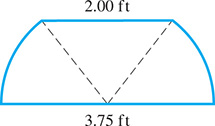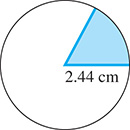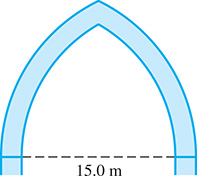CHAPTER 8 REVIEW EXERCISES
CONCEPT CHECK EXERCISES
Determine each of the following as being either true or false. If it is false, explain why.
If is a fourth-quadrant angle, then
For and then
To convert an angle measured in radians to an angle measured in degrees, multiply the number of radians by
The length of arc s of a circular arc of radius r and central angle (in radians) is
If the sine and cosine of an angle are both negative, then the angle must terminate in the third quadrant.
PRACTICE AND APPLICATIONS
(6, 8)
,
,
,
,
0.560
14.5
Without a calculator, evaluate
Without a calculator, evaluate
In Fig. 8.53, show that the area of a design label (a segment of a circle) intercepted by angle is Find the area if cm and

Fig. 8.53
The cross section of a tunnel is the major segment of a circle of radius 12.0 ft wide. The base of the tunnel is 20.0 ft wide. What is the area of the cross section? See Exercise 79.
Find (a) the area and (b) the perimeter of the parcel of land shown in Fig. 8.54. Its shape is a right triangle attached to a circular sector.

Fig. 8.54
The speedometer of a car is designed to be accurate with tires that are 14.0 in. in radius. If the tires are changed to 15.0 in. in radius, and the speedometer shows 55 mi/h, how fast is the car actually going?
The instantaneous power p (in W) input to a resistor in an alternating-current circuit is where is the maximum power input and t is the time (in s). Find p for and
The horizontal distance x through which a pendulum moves is given by where a is a constant and is the angle between the vertical and the pendulum. Find x for and
A sector gear with a pitch radius of 8.25 in. and a 6.60-in. arc of contact is shown in Fig. 8.55. What is the sector angle

Fig. 8.55
Two pulleys have radii of 10.0 in. and 6.00 in., and their centers are 40.0 in. apart. If the pulley belt is uncrossed, what must be the length of the belt?
A special vehicle for traveling on glacial ice in Banff National Park in the Canadian Rockies has tires 4.8 ft in diameter. If the vehicle travels at 3.5 mi/h, what is the angular velocity (in r/min) of a tire?
A rotating circular restaurant at the top of a hotel has a diameter of 32.5 m. If it completes one revolution in 24.0 min, what is the velocity of the outer surface?
Find the velocity (in mi/h) of the moon as it revolves about the Earth. Assume it takes 28 days for one revolution at a distance of 240,000 mi from the Earth.
The stopboard of a shot-put circle is a circular arc 1.22 m in length. The radius of the circle is 1.06 m. What is the central angle?
 The longitude of Anchorage, Alaska, is W, and the longitude of St. Petersburg, Russia, is E. Both cities are at a latitude of N. (a) Find the great circle distance (see page 254) from Anchorage to St. Petersburg over the north pole. (b) Find the distance between them along the N latitude arc. The radius of the Earth is 3960 mi. What do the results show?
The longitude of Anchorage, Alaska, is W, and the longitude of St. Petersburg, Russia, is E. Both cities are at a latitude of N. (a) Find the great circle distance (see page 254) from Anchorage to St. Petersburg over the north pole. (b) Find the distance between them along the N latitude arc. The radius of the Earth is 3960 mi. What do the results show?A piece of circular filter paper 15.0 cm in diameter is folded such that its effective filtering area is the same as that of a sector with central angle of . What is the filtering area?
To produce an electric current, a circular loop of wire of diameter 25.0 cm is rotating about its diameter at 60.0 r/s in a magnetic field. What is the greatest linear velocity of any point on the loop?
Find the area of the decorative glass panel shown in Fig. 8.56. The panel is made up of two equal circular sectors and an isosceles triangle.

Fig. 8.56
A circular hood is to be used over a piece of machinery. It is to be made from a circular piece of sheet metal 3.25 ft in radius. A hole 0.75 ft in radius and a sector of central angle are to be removed to make the hood. What is the area of the top of the hood?
The chain on a chain saw is driven by a sprocket 7.50 cm in diameter. If the chain is 108 cm long and makes one revolution in 0.250 s, what is the angular velocity (in r/s) of the sprocket?
An ultracentrifuge, used to observe the sedimentation of particles such as proteins, may rotate as fast as 80,000 r/min. If it rotates at this rate and is 7.20 cm in diameter, what is the linear velocity of a particle at the outer edge?
A computer is programmed to shade in a sector of a pie chart 2.44 cm in radius. If the perimeter of the shaded sector is 7.32 cm, what is the central angle (in degrees) of the sector? See Fig. 8.57.

Fig. 8.57
A Gothic arch, commonly used in medieval European structures, is formed by two circular arcs. In one type, each arc is one-sixth of a circle, with the center of each at the base on the end of the other arc. See Fig. 8.58. Therefore, the width of the arch equals the radius of each arc. For such an arch, find the area of the opening if the width is 15.0 m.

Fig. 8.58
The Trans-Alaska Pipeline was assembled in sections 40.0 ft long and 4.00 ft in diameter. If the depth of the oil in one horizontal section is 1.00 ft, what is the volume of oil in this section?
A laser beam is transmitted with a “width” of and makes a circular spot of radius 2.50 km on a distant object. How far is the object from the source of the laser beam? Use Eq. (8.12) on page 259.
The planet Venus subtends an angle of to an observer on Earth. If the distance between Venus and Earth is what is the diameter of Venus? Use Eq. (8.12) on page 259.
 Write a paragraph explaining how you determine the units for the result of the following problem: An astronaut in a spacecraft circles the moon once each 1.95 h. If the altitude of the spacecraft is constant at 70.0 mi, what is its velocity? The radius of the moon is 1080 mi. (What is the answer?)
Write a paragraph explaining how you determine the units for the result of the following problem: An astronaut in a spacecraft circles the moon once each 1.95 h. If the altitude of the spacecraft is constant at 70.0 mi, what is its velocity? The radius of the moon is 1080 mi. (What is the answer?)
